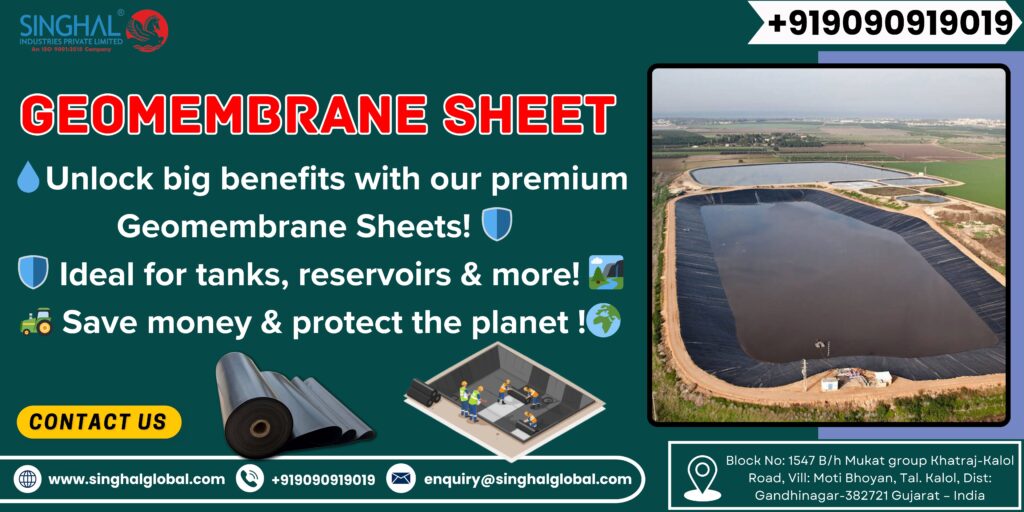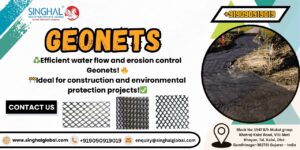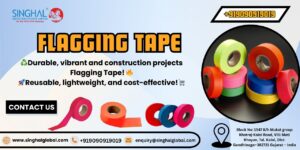It is somehow poetic watching water taking its shape through the terrains, until it cuts out our lifeline. Fortunately, geomembrane liners are the solution that modern civil engineering offers. These strong, non-permeable sheets especially the HDPE geomembrane sheets are used by geomembrane manufactures in India to cover the dams, canals, fish ponds and land fill sites, etc. to shield these places against water.
In this paper we will learn the protection provided to us by geomembranes, the way geomembranes are manufactured and utilized, some Indian facts and figures, and whether geomembranes are a really sustainable solution.
The Big Problem: Erosion & Seepage
You know what it is: a stream on the mountain which carries off the soil and leaves the land bare; or a water-course that is cut out of the ground. There is also the possibility that hidden damage can be caused by seepage, dam walls become weak, retaining structures begin to crack and the cost of making repair will become a certainty. I recall going to a minor dam near Pune which had a seepage problem. Water was creeping close to the bottom, and turning solid ground to mush. The scene was devastating as decades of work was jeopardized by a small leak.
Engineers required something that will be durable and yet should be economical; they got it in the form of geomembrane liners.
What Exactly Is a Geomembrane?
Simply, a geomembrane is a synthetic membrane that is constructed out of such material as polyethylene or PVC and which is almost impervious to liquid and gas permeation. Among the latter, HDPE geomembrane sheet are most popular. Why HDPE? Since it is extremely hard, resistant to the sun, and chemically non-responsive. In other words, it does not decompose under the influence of sun, acids and bases in soil and in waste. In practice, it would be like lining a pond by use of a tank but stretchable and of course easier to lay.
Popular Applications in India
In pretty much every place either water is needed or needs containment:
- Irrigation channels and farm water bodies– in order to avoid leaking of water to ground water.
- Fish and fish culture ponds – lining them to make the water clean and prevent leakage.
- Landfills – to prevent the pollution of the environment by toxic leachate.
- Mine activities – to contain polluted water in a way that it does not pollute soil and groundwater.
- Rainwater harvesting pits and tanks faculties – enhancing water storing levels.
In a rural fish farming project in Andhra Pradesh they replaced a pond lined with clay with one patched with HDPE geomembrane sheet and saw their water retention increase by 60%. The farmers were elated–and so was I as I saw the smile on the faces of the farmers.
Who Makes These Sheets?
The local Geomembrane manufacturers in India have answered the cause in a big way. States such as Gujarat and Maharashtra have businesses dealing with high grade sheets of international standards. This change has also lessened our dependency on costly imports, and made many of our local programs thrive- even in other distant areas such as the western ghats and odisha.
Understanding Geomembrane Sheet Price in India
Naturally, the Geomembrane sheet price is important:
- Thickness (usual range 0.5mm 2.0mm)
- Breadth and roll length
- Backing such as geotextile backings
- Certifications and brand power Applying for certifications and Having a good brand.
Real-Life Project: Canal Lining in Rajasthan
In the water scarce state of Rajasthan, a canal-bed that was supposed to deliver water over a distance of 20 km was leaking profusely. During monsoons, repair requests surmounted. The government of the state was in approval of a project of canal re-lining with geomembrane liners. In a matter of months the seepage was reduced to an extremely low amount. Officials in the canal were thanked by farmers who praised them on restoring their lives. Installing it was easy according to engineers. Others went to the extent of making jokes such as, we are no longer watering the earth but the crops themselves!
Installation Insight
Indian companies are also experiencing an increased demand in the geomembrane suppliers due to the ease with which the material can be installed as opposed to the traditional alternative. You unroll the sheet, weld seams with help of hot air or extrusion technique, check joints, and fix edges. It is surprisingly quicker most especially compared to traditional concrete linings or clay compaction. And yes you may laugh now at the way the old methods were, because you know this is a real step forward.
Challenges and Risks
Unless correctly installed seams may break or liner may puncture. There are also some places that might require additional protection such as underlayment by geotextile. It requires an initial investment that small farmers occasionally pat standard.
However, it is often more convenient and dependable than either conventional concrete lining or more messy, or labor intensive, clay fills or stonework.
Conclusion
Geomembrane liners that are known as HDPE geomembrane sheets are silently transforming water management and erosion control in India marvellously. They are not glamours but they are powerful, functional and they are becoming more and more available courtesy of local geomembrane producers in India.
Of course, it has contradictions. They are made of plastic yet they help in saving lands and damaging the environment. They are expensive to buy but the savings are made in the long term. There are several trade-offs in life but on balance, it appears that geosynthetics are a savvy bet.
Frequently Asked Questions (FAQs)
Q.1 In which place is geomembrane typically used?
Some of the projects where geomembranes are used include ponds, canals, landfill sites, mining sites, irrigation system and rainwater harvesting tank. The major role of these is to avoid seepage or leakage.
Q.2 What are the varieties of geomembranes?
HDPE is favorite because of its physical strength, chemical resistance, and stability against UV.
Q.3 Can geomembrane apply to fish pond?
Absolutely. Geomembrane liner is often used in fish farms in aquaculture to keep water levels steady, stop water losses that occur through seepage and limit contamination. The result? Healthier fish, easier to control and happy farmers.
Q.4 Is geomembrane friendly or recyclable?
It has been found that the HDPE liners are recyclable and can be taken out and used again in the situation that they can be taken apart in a careful manner. They have long life ensuring they are not replaced easily.









